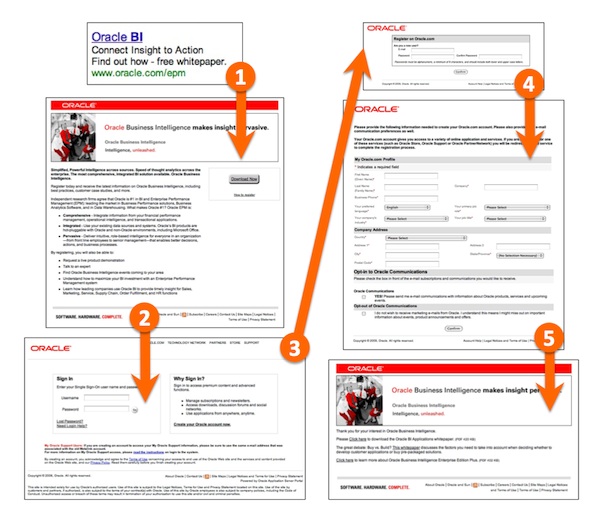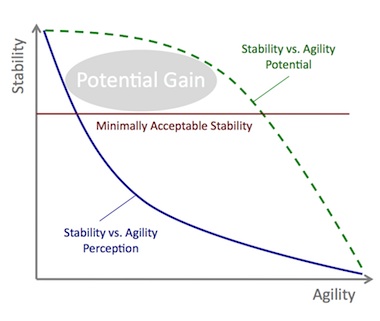I believe marketing must lead its own technology.
As detailed in my presentation Rise of the Marketing Technologist, I think marketing departments need marketing technologists on staff, led by a marketing CTO who reports to the CMO. It’s the only prayer marketing has in a world where technology is infused into every medium and message, operating and innovating at Google speed.
Predictably, this is not a popular view in the IT department.
IT’s self-identity for the past several decades has been obvious: IT owns all technology in the organization. It’s their responsibility — and their budget and their staff — to make sure it all works, reliably, securely, and economically.
Admittedly, such stability comes at the cost of some agility for business owners, but hey, that’s the price of poker. IT takes their responsibility seriously.
They also have a sinister name for reckless business owners who run their own technology initiatives outside of the IT department: shadow IT. Sounds like a CIA plot. Eric D. Brown has a great post describing this phenomenon: Shadow IT (aka Doing What IT Won’t/Can’t).
Now, in all fairness, the concerns about shadow IT are legitimate:
- compliance requirements (such as Sarbanes-Oxley) may not be met
- security standards may be lax, creating risk for the company and its customers
- reliability might suffer without sufficient capacity, redundancy, or testing
- incompatibilities with other systems in the organization may arise unexpectedly
- duplication of effort with different teams doing the same thing different ways
These are the reasons usually given for why marketing technology should stay under the reign of IT, not marketing. However, while it’s important to address these issues, I reject the premise that the only solution is to keep everything under IT’s control. I have two counter-arguments:
- The dangers of “shadow marketing” are significant too.
- Formalizing marketing’s technology team makes it responsible.
There are other counter-arguments, such as the fundamental shift cloud computing is having on business overall (see Nicholas Carr’s The Big Switch), and the fact that in software companies, product development teams are great examples of successful technology groups outside of IT. But the two we’ll cover here haven’t been discussed as much.
#1. The dangers of “shadow marketing” are significant too.
Analogous to shadow IT, shadow marketing is when groups outside of the marketing department seize control of aspects of marketing’s strategy or execution. For instance, purchasing might dictate how marketing selects vendors. Or legal might restrict who can speak on the company’s behalf in social media channels. Or sales might run their own email campaigns that inadvertently conflict with another marketing campaign.
These shadow forces subvert marketing, not because they intentionally want to cause trouble, but simply because it serves their interests. Although everyone theoretically wants what’s best for the company, the perspective of “what’s best” depends on your job description, your boss, your budget — your incentives.
In no department is shadow marketing more rampant than IT. In most organizations today, the IT department has enormous control over marketing technology — the web site, the content management system, the CRM database. They exert their authority over budgeting, vendor selection, configuration restrictions, operating guidelines, etc.
The problem is that these are not merely back-office decisions. Your choice of marketing software — and how it’s adopted, configured, and operated — impacts customer experiences and market competitiveness. Marketing is long past the days of Mad Men. It’s not all catchphrases and cocktails. Modern marketing is about the holistic experience that people have with your organization, and for most companies, I’ll bet that 80% or more of those touchpoints are shaped somehow by software.
Let me give you an example. The following is a landing page experience that I had earlier this year. I did a search for “business intelligence software” on Google and saw an ad from Oracle promising a free whitepaper. When I clicked, this is the Byzantine experience I had to traverse:
I had to go through a sign-in screen, an account registration that demanded a secure password, and then fill out a long account profile form — just to have the privilege of reading their marketing material. I’d be surprised if more than 10% of the people who click on that ad have the patience for that process. Meanwhile, the ads from competitors take you to their fulfillments immediately or after a single-page form.
This wreaks of shadow marketing, where IT probably decided there should be one registration process for everything in the oracle.com domain, regardless of context. From IT’s perspective, that decision facilitates compliance, security, reliability, reusability, etc. But from a marketing perspective, it sucks, and it’s undoubtedly costing them leads and customers.
Shadow IT is scary because risks associated with bad IT can damage and even destroy companies. But companies also are damaged and destroyed by other forces — primarily competition — when they fail to keep pace with the market and their customers. That’s a far more common catastrophe, and when stomping out shadow IT causes shadow marketing to mushroom, you’re escalating this other source of risk.
#2. Formalizing marketing’s technology team makes it responsible.
Marketing already has technologists in its ranks. However, for the most part, they fly under the radar of a company’s executive management team. They’re tactical facilitators, helping with SEO, analytics, and smaller cloud-based services that are purchased without IT’s knowledge. Because they’re unofficial, they lack resources, authority, and cohesiveness — and that hinders their effectiveness and leads to the dangers of shadow IT.
Creating an official marketing technology team under the marketing department, run by a marketing CTO, doesn’t make this situation worse — it makes it significantly better. This is no longer shadow IT, because they’re no longer invisible to IT. They’re out in the open, able to talk and collaborate with IT on-the-record.
By formally taking over marketing technology, marketing consciously takes responsibility for the concerns around compliance, security, reliability, and cost-effectiveness. The difference is that marketing is now able to balance those concerns with a broader set of issues — most importantly customer experiences and competitiveness.
Frankly, these trade-offs are not as black-and-white as they sometimes seem when marketing and IT are in log-jammed debates. For instance, it’s often claimed that more agility means less stability. But there are many different ways to achieve agility, sometimes with very little risk to stability. But you have to be willing to change your practices and priorities, and that’s hard to do across organizational boundaries.
By bringing the pros and cons together under the mantle of a single team, the politics and turf wars are greatly alleviated, and more creative solutions can emerge.
“But marketing’s not qualified to trade-off those technical issues!” an IT manager might protest.
We’re not talking about putting copywriters and graphic designers in charge of marketing technology. The marketing technology team would consist largely of engineers, and the marketing CTO should be as savvy a technologist as anyone. He or she will have extensive experience in IT or software development.
And just so we’re on the same page, keeping the company out of legal or security debacles, having a fast and reliable service, and doing it all as efficiently as possible, is very much in marketing’s interest. Given the power and the responsibility, I believe they can use good judgment in balancing the overall picture.
“But can’t this marketing technology team live in IT?” the IT manager might counter.
If this were solely a technical challenge, it could. But it’s not. The real problems with having IT run marketing technology are organizational.
- Budgeting: who gets to decide what to spend money on, when to spend that money, and how quickly to make changes?
- Human resources: who gets to decide who is hired to work on these projects?
- Prioritization: who decides what takes precedent when conflicts and contention arise (as they do every week)?
But possibly the biggest issue is simply worldview.
IT people work for IT. Marketing people work for marketing. And, as illustrated with the dangers of shadow marketing, marketing technology is now an integral part of marketing’s strategy and execution. The people working on it need to have their focus — and more importantly, their passion — on marketing outcomes. You can’t get there with dotted lines and chargebacks.
Because they’re not a part of marketing, even a really good “marketing service group” in IT can’t cross this crucial barrier. Unless they become so independently embedded in marketing — mentally, emotionally, physically, and organizationally — that they essentially become the internal marketing technology team. They’ve gone native.
In which case, welcome aboard!






Scott – Great writeup and wonderfully thorough description of the issues facing the marketing function.
While I wouldn’t go so far as to say that Marketing should run its own IT, I do think Marketing should own its technology and manage that technology. There’s a lot that has to be done, namely bringing technologists into the marketing function to better help IT and Marketing communicate and work together.
There’s a lot to be done to help better integrate marketing and IT in the future…looking forward reading more from you on the topic…and I’m planning on writing more on it as well.
Great stuff here Scott.
Scott,
you hit the nail on the head. IT should be in an advisory, supportive role. Marketing needs to step up and create this fiefdom else it will always be at the mercy of an IT department with other priorities to tinker with.
I tried to address this gap with “The CIO’s Quickie Guide to Marketing Automation” with the intent of showing them that Marketing and its needs were nothing to ignore or fear:
http://allinio.com/resources/the-cios-quickie-guide-to-marketing-automation/
Hopefully more marketers will be encouraged by this blog post.
Hi, Eric — thanks for the great comment. I’ve been reading your blog, and I’ve become a big fan of your writing and thinking on modern IT. It was actually your recent “CIOs: Consider This” post that linked me to your older post on shadow IT that was the seed of inspiration for this post.
I know there’s a continuum of possibilities in how marketing and IT can collaborate, and my ideas are pretty far to one side. In a lot of situations, the best solution will depend on the specifics of the organization and the people involved. I also think this “best solution” will be a moving target in the years ahead, evolving with technology and shifts in organizational structure and culture.
But in a world where marketing technology may take shape in forms that are very different than what we’ve thought of as “IT” in the past, it’s not that radical to think of a tech team in marketing running it directly. A new generation of functional embedded IT facilitated by the cloud generation.
I definitely look forward to reading more of your thoughts on this subject!
Hey Scott –
Glad some of my stuff is providing some value to the community…love the fact that something I wrote inspired a great piece like this!
And…this post has inspired me to write one on the topic of IT & Marketing working together…hope it turns out well.
Thanks for the encouraging comment, Joe. Love the CIO’s Quickie Guide!
Eric — I’m looking forward to your piece on this topic with great anticipa